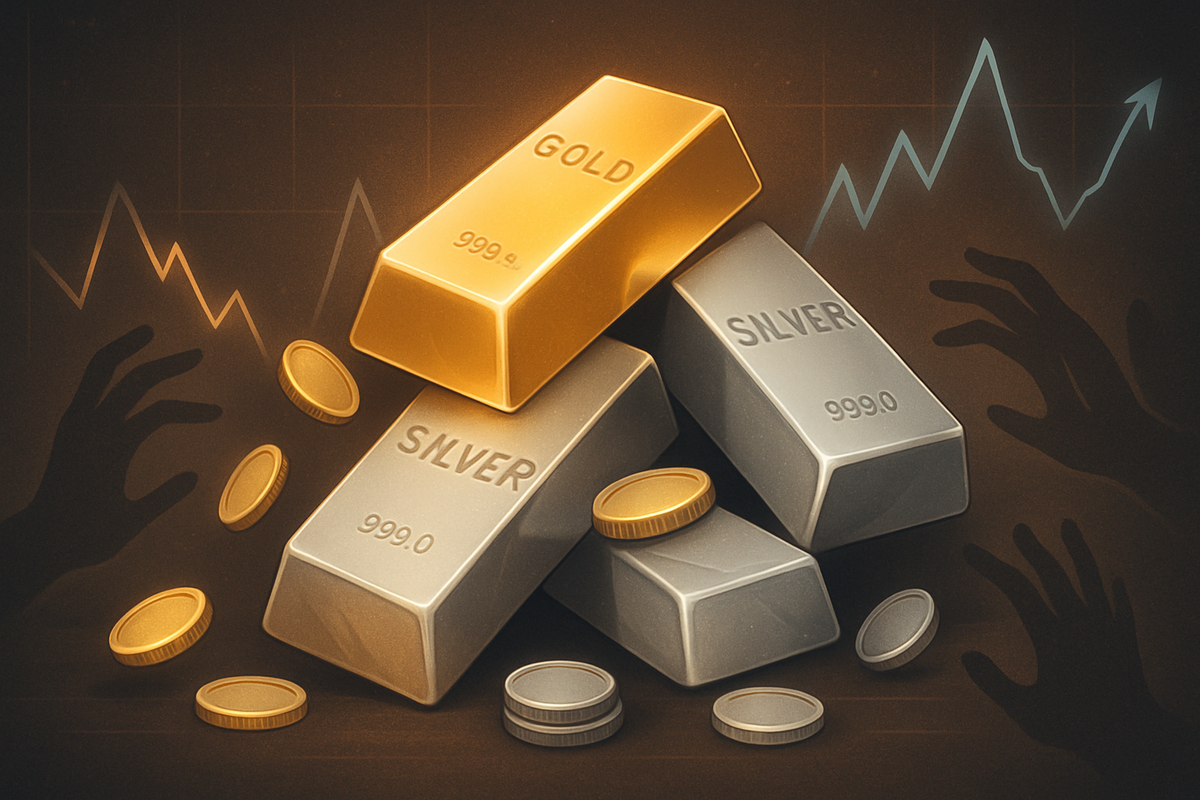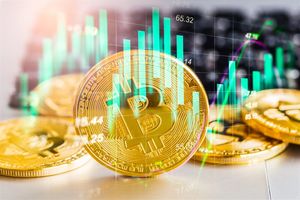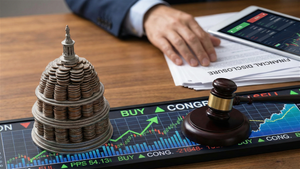Financial News
Gold and Silver Surge Amidst Bargain Hunting Frenzy, Market Braces for Volatility

Precious metals, gold and silver, have recently captivated global financial markets with a remarkable display of strength, reaching unprecedented nominal highs in early October 2025. Following these historic peaks, both metals experienced sharp corrections, only to rebound swiftly as investors engaged in aggressive 'bargain buying.' This dynamic market activity, characterized by significant volatility and a mix of caution and long-term bullish conviction, is sending ripples across the financial landscape, prompting a re-evaluation of safe-haven assets amidst ongoing geopolitical uncertainties and shifting monetary policies.
The immediate implications of this surge and subsequent rebound are multifaceted, highlighting a market grappling with profit-taking pressures alongside a firm belief in the intrinsic value of precious metals. Investors are strategically leveraging price dips, viewing them as opportune entry points, driven by a confluence of factors including anticipated interest rate cuts, persistent inflation concerns, and a weakening U.S. dollar. This intense trading activity underscores a pivotal moment for gold and silver, signaling their continued role as critical components in diversified investment portfolios.
Unprecedented Peaks and Swift Reversals: A Detailed Market Chronicle
The recent trajectory of gold and silver prices has been nothing short of extraordinary, marked by a rapid ascent to record nominal highs followed by equally dramatic corrections and subsequent rebounds, all within a compressed timeframe. Gold prices touched an astonishing $4,398 per ounce on October 20, 2025, while silver soared to a new all-time high of $55.51 per ounce. These figures represent a substantial rally throughout 2025, with gold climbing an impressive 58% and silver a staggering 69% year-to-date, reflecting a robust bullish sentiment that has permeated the market for much of the year.
However, the euphoria of these record highs was quickly tempered by a sharp market correction. On October 21-22, 2025, gold experienced its largest single-day percentage decline in over a decade, plummeting more than 6%. Silver, known for its higher volatility, endured an even steeper drop, shedding nearly 10% in a single day—its steepest fall since 2021. This sudden downturn triggered a wave of profit-taking, leading many to question the sustainability of the rally. Yet, the ensuing rebound on October 23, 2025, driven by aggressive "bargain buying" and "value buying," emphatically demonstrated that many investors viewed these dips as attractive entry points rather than signals of a fundamental weakness.
Key players in this unfolding drama include a diverse range of investors, from institutional funds and central banks to individual retail traders. Central banks, in particular, have been consistent accumulators of gold, diversifying their foreign currency reserves and hedging against systemic instability. On the other hand, retail investors, driven by a "Fear of Missing Out" (FOMO) as gold prices doubled over the past two years, have also played a significant role in pushing prices higher after dips. The immediate market reaction to the corrections was a palpable increase in volatility across asset classes. While the precious metals themselves saw significant swings, U.S. equities, including the Dow Jones (NYSE: DIA), S&P 500 (NYSE: SPY), and Nasdaq (NASDAQ: QQQ), also experienced declines on October 22, indicating a broader shift in investor sentiment from riskier assets. Exchange-Traded Funds (ETFs) backed by gold and silver also felt the direct impact, with notable declines in their net asset values during the profit-taking phase.
The underlying drivers of this sustained interest in precious metals are multifaceted. The U.S. Federal Reserve's initiation of interest rate cuts in September 2025 has made non-interest-bearing assets more appealing. Expectations of further cuts by mid-2026 reduce the opportunity cost of holding gold and silver. Geopolitical instability, including ongoing conflicts in Eastern Europe and the Middle East, along with domestic uncertainties like U.S. government shutdown threats and trade-tariff worries, continues to fuel safe-haven demand. Furthermore, persistent core inflation in many developed economies leads investors to seek traditional hedges against purchasing power erosion. A weakening U.S. dollar also enhances the attractiveness of dollar-denominated commodities for international buyers. For silver, its critical industrial applications in electronics, solar panels, and electric vehicles provide an additional layer of demand, making it a "cheap alternative to gold" with similar portfolio protection benefits.
Corporate Fortunes Tied to Metal's Mettle
The recent volatility and strong performance in gold and silver prices have created a clear distinction between potential winners and losers within the corporate landscape, particularly for companies directly involved in the mining, processing, and industrial application of these metals.
Potential Winners:
- Gold and Silver Mining Companies with Low All-in Sustaining Costs (AISCs): Miners like Barrick Gold (NYSE: GOLD), Newmont Corporation (NYSE: NEM), and Wheaton Precious Metals (NYSE: WPM) with efficient operations and lower production costs are poised to benefit significantly from elevated metal prices. Their profit margins expand considerably, allowing for increased capital expenditures, debt reduction, or enhanced shareholder returns through dividends and buybacks. The higher the price, the more economically viable lower-grade ore bodies become, potentially extending mine life and increasing reserves.
- Precious Metals Streamers and Royalty Companies: Companies such as Franco-Nevada Corporation (NYSE: FNV) and Royal Gold (NASDAQ: RGLD) that provide upfront financing to miners in exchange for a percentage of future production or revenue stand to gain immensely. Their business model offers leverage to rising metal prices without direct exposure to the operational risks and capital intensity of mining.
- Refiners and Dealers of Precious Metals: Firms involved in the refining, manufacturing, and distribution of gold and silver bullion, coins, and bars experience increased demand during periods of heightened investor interest. Companies like Johnson Matthey (LSE: JMAT) (though also diversified in other materials) and various private mints and dealers see higher transaction volumes and potentially wider margins.
- Industrial Users (during corrections): Industries that heavily rely on silver as a raw material, such as solar panel manufacturers (e.g., First Solar (NASDAQ: FSLR)), electronics companies (e.g., Apple (NASDAQ: AAPLE) for connectors), and electric vehicle battery producers, could temporarily benefit from price corrections. Lower input costs, even if fleeting, can improve their cost structures and competitiveness.
Potential Losers:
- High-Cost Gold and Silver Mining Companies: Conversely, miners with high AISCs or those operating marginal mines will struggle to capitalize on the price increases. Their profitability remains constrained, and they may face challenges in sustaining operations if prices become too volatile or if corrections are prolonged.
- Companies with Unhedged Exposure to Price Declines: While many mining companies hedge a portion of their production, those with significant unhedged exposure to gold and silver prices could face substantial revenue and profit declines during sharp corrections, impacting their financial stability.
- Jewelry and Luxury Goods Retailers (potentially): While a complex relationship, sustained high gold prices can sometimes dampen consumer demand for gold jewelry, as it becomes more expensive. Luxury brands like Tiffany & Co. (owned by LVMH (LVMUY)) might see shifts in consumer preferences towards alternative materials or lower caratage items if gold remains prohibitively high.
- Speculators Caught on the Wrong Side: Investors or hedge funds taking highly leveraged positions anticipating continued price rises could face significant losses during sharp corrections, especially in the more volatile silver market.
The impact on these companies is not static; it ebbs and flows with market sentiment and price movements. While high prices generally benefit producers, the intense volatility seen recently introduces an element of risk, demanding agile management and robust hedging strategies to navigate the shifting landscape effectively.
Broader Implications and Historical Echoes
The recent surge and subsequent bargain-driven rebound in gold and silver prices are not isolated incidents but rather significant indicators within broader industry trends and macroeconomic shifts. This event underscores a renewed confidence in precious metals as a hedge against systemic risks, fitting squarely into a narrative of de-dollarization efforts by central banks and a global re-evaluation of reserve assets.
The phenomenon of "bargain buying" after sharp corrections highlights a persistent underlying demand, suggesting that investors view these metals not merely as speculative assets but as fundamental stores of value. This trend is consistent with historical patterns where geopolitical instability, inflationary pressures, and monetary policy uncertainties have traditionally propelled investors towards safe-haven assets. For instance, the gold bull market of the 1970s, fueled by high inflation and geopolitical turmoil, serves as a powerful precedent, demonstrating how precious metals can perform strongly in environments of economic uncertainty. More recently, the post-2008 financial crisis period also saw a significant rally in gold as central banks embarked on quantitative easing, devaluing fiat currencies and boosting demand for tangible assets.
The ripple effects of this precious metals rally extend far beyond the mining sector. Competitors in the broader investment landscape, such as traditional bond markets, may find themselves less attractive as non-interest-bearing gold and silver offer competitive returns, particularly in an environment of falling real interest rates. Partners in the industrial sector, especially those relying on silver for manufacturing, face a delicate balance: while temporary price corrections offer relief, sustained high prices could impact their input costs and profit margins in the long run, potentially spurring innovation in material substitution or efficiency gains.
Regulatory and policy implications also loom large. Sustained high prices could prompt governments to re-evaluate mining regulations, potentially incentivizing domestic production or imposing new taxes on windfall profits. Moreover, the increasing role of precious metals in global reserve strategies might influence international trade dynamics and currency valuations, potentially accelerating the move away from U.S. dollar dominance in certain spheres. The extended U.S. government shutdown (22 days as of October 22, 2025), cited as a factor fueling safe-haven demand, underscores how domestic political instability can have profound global financial consequences, pushing investors towards perceived stability offered by gold and silver. This event serves as a stark reminder of the interconnectedness of political, economic, and market forces, reinforcing the historical role of precious metals as barometers of global confidence and stability.
The Road Ahead: Navigating Precious Metals' Future
As gold and silver prices continue their volatile yet upward trajectory, market participants are keenly looking ahead to discern the short-term fluctuations and long-term implications. The immediate future is likely to be characterized by continued price swings, as traders navigate profit-taking opportunities against the backdrop of sustained bullish sentiment. In the short term, investors should anticipate further periods of consolidation and potential corrections, which, if recent history is any guide, will likely be met with renewed bargain buying. The interplay between geopolitical developments, central bank rhetoric, and economic data releases—particularly inflation figures and interest rate guidance—will dictate daily price movements.
Looking further out, the long-term outlook for precious metals appears robust. The structural drivers underpinning the current rally, including ongoing geopolitical tensions, the global trend towards monetary easing, and persistent inflation concerns, are unlikely to dissipate quickly. This suggests that gold and silver could maintain their elevated price levels, potentially even pushing higher, as investors continue to seek reliable stores of value. Potential strategic pivots for investors and corporations include diversifying portfolios to include a greater allocation to precious metals, and for mining companies, focusing on operational efficiency and exploring new deposits to capitalize on higher prices.
Market opportunities are emerging for those who can effectively manage risk. This includes opportunities in precious metal-backed ETFs, mining company equities (especially those with low AISCs), and even direct physical metal holdings. Challenges, however, include managing the inherent volatility, accurately forecasting interest rate paths, and assessing geopolitical risks. Potential scenarios range from a continued steady ascent, driven by a weakening dollar and persistent global instability, to more dramatic spikes if a major geopolitical event or economic crisis unfolds. Conversely, a rapid resolution of global conflicts or a more aggressive tightening of monetary policy could temper the rally, though this seems less likely given current projections.
The enduring appeal of gold and silver as critical portfolio components is set to remain a defining feature of the financial landscape. Investors should watch for key indicators such as further interest rate decisions by major central banks, any de-escalation or intensification of geopolitical conflicts, and changes in global inflation expectations. The strength of the U.S. dollar will also be a critical factor, as a continued weakening would further enhance the attractiveness of dollar-denominated commodities.
Concluding Thoughts: A Golden Era of Uncertainty
The recent performance of gold and silver in the financial markets serves as a compelling testament to their enduring role as safe-haven assets and inflation hedges in an era defined by uncertainty. The dramatic surges to record highs, followed by sharp corrections and a swift resurgence driven by bargain buying, underscore a deeply rooted investor conviction in the intrinsic value of these precious metals. This period of heightened volatility and significant gains highlights a market undergoing a fundamental re-evaluation, where traditional financial instruments are increasingly viewed through the lens of macroeconomic instability and geopolitical risk.
Moving forward, the market for gold and silver is poised to remain dynamic and influential. Key takeaways from this event include the powerful impact of monetary policy shifts, particularly interest rate cuts, on non-yielding assets; the persistent demand for safe havens amidst a complex geopolitical environment; and the significant role of industrial demand, especially for silver, in bolstering its appeal. Investors should recognize that while profit-taking pressures will continue to create short-term fluctuations, the underlying structural drivers for precious metals remain robust.
The lasting impact of this rally is likely to solidify gold and silver's position as essential components of diversified portfolios, offering a counterbalance to equity market volatility and currency depreciation. What investors should watch for in the coming months includes the trajectory of global interest rates, any significant shifts in central bank gold accumulation, and the evolution of geopolitical flashpoints. The current landscape suggests that the "golden era" for precious metals, fueled by a confluence of economic and political factors, is far from over, demanding vigilance and strategic foresight from all market participants.
This content is intended for informational purposes only and is not financial advice
More News
View More




Recent Quotes
View More
Quotes delayed at least 20 minutes.
By accessing this page, you agree to the Privacy Policy and Terms Of Service.



